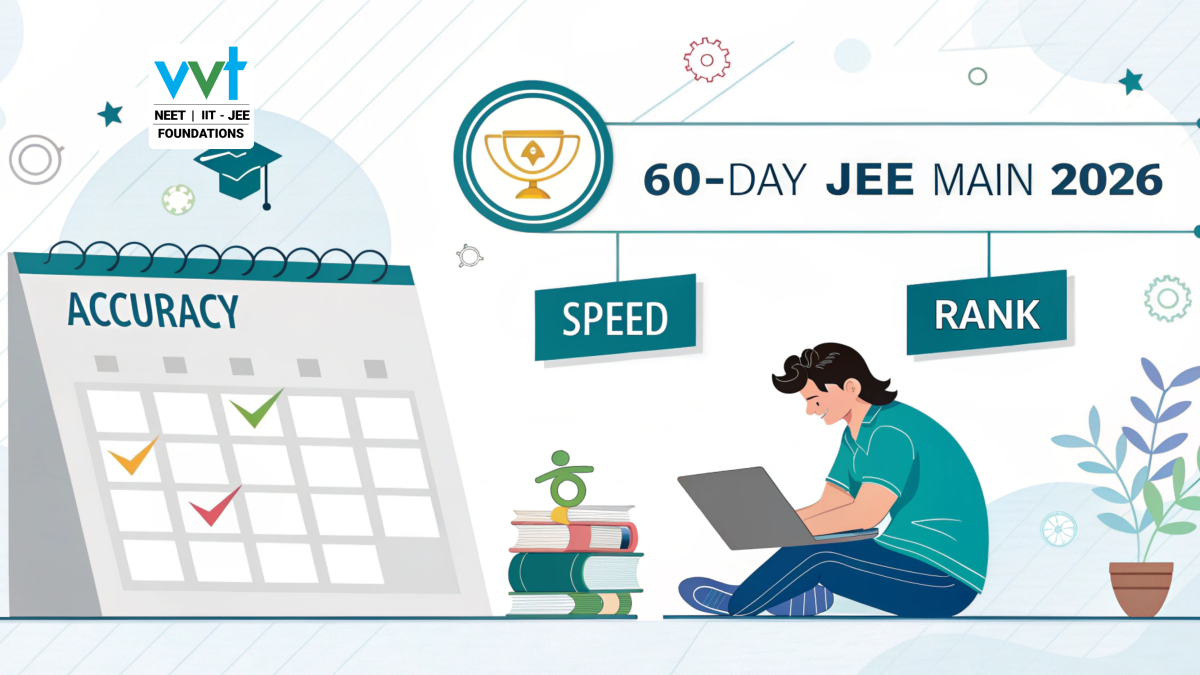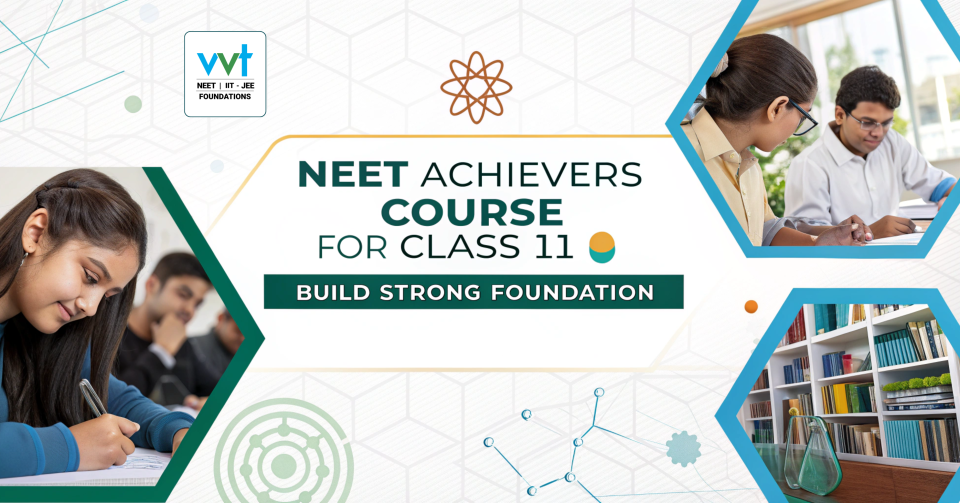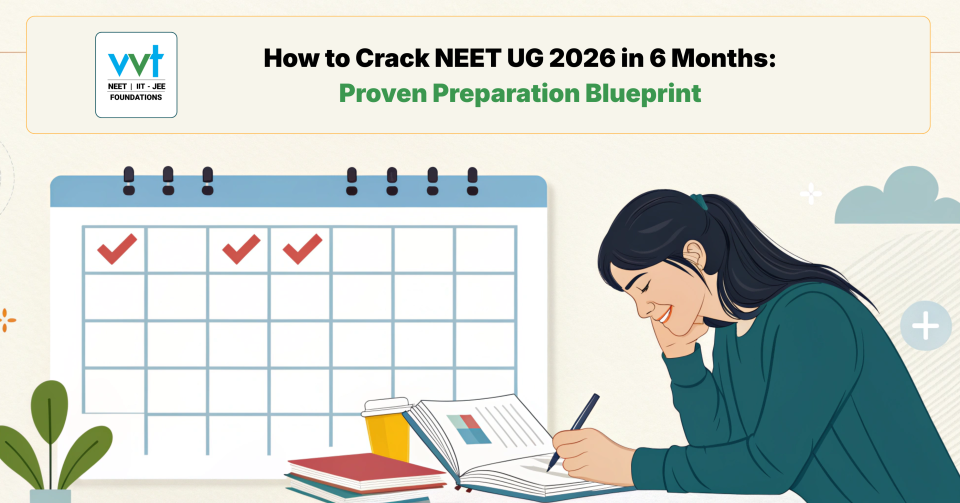
NEET UG 2026 Entrance Exam: Complete Guide for Medical Aspirants
November 23, 2025
JEE Main 2026: Registration Ends in 3 Days — Latest Updates, Deadlines & 3-Day Rescue Plan
November 25, 202560-Day JEE Main 2026 Plan to Boost Accuracy, Speed & Percentile
The final 60 days before JEE Main are not about learning everything, they’re about executing a tight system that improves accuracy under time, question selection, and mock-to-analysis loops. This guide gives you a week-by-week blueprint, daily schedule, topic map, and a realistic mock plan so your percentile climbs predictably.
What You’re Optimising For (Paper-1 Quick Facts)
- Mode: CBT (Physics, Chemistry, Mathematics)
- Marks: 300 | Scoring: +4 for correct, −1 for wrong, 0 unattempted
- Goal in 60 days: Raise accuracy, then expand attempts, reduce negatives, automate first-pass triage
The 60-Day Blueprint (Week by Week)
During Weeks 1–2, you’ll focus on Baseline & Fundamentals.
- Physics: Kinematics, NLM, WEP; basic Electrostatics (units/signs discipline)
- Chemistry: Chemical Bonding (VSEPR/MO), GOC, Thermodynamics & Equilibrium basics
- Maths: Quadratics, Matrices & Determinants, Limits/Continuity/Differentiation, Vectors/3D (intro)
- Tests: 2 full mocks total + 4 chapter tests/week
- Deliverable: Start an Error Log (tag each error: concept / careless / time-pressure)
Weeks 3–4: Pattern Drilling & PYQ Rhythm
- Physics: Rotation/COM, SHM & Waves, Current Electricity; 10 graph Qs/day
- Chemistry: Ionic/Chemical Equilibrium, Electrochem (basics), Carbonyls & Amines; reagent→effect flash grid
- Maths: Definite Integration, Area (AOD/AOI), Straight Line–Circle, Conics, Probability
- Tests: 3 full mocks/week + 4–6 chapter/section tests
- Deliverable: For every mock, write 3 micro-fixes you’ll apply next attempt
Weeks 5–6: Percentile Push (Stabilise Accuracy → Expand Attempts)
- Strong topics: 60–70% of daily time (convert to near-error-free)
- Weak topics: Micro-sessions (20–30 min) + 15 targeted Qs → re-test in 48–72 hrs
- Tests: 4 full mocks/week (alternate days) + 2 subject tests
- Deliverable: Slot selection strategy, first-pass triage, break timing, last 15-minute revisit plan
High-Yield Topic Map (Last-60 Focus)
| Subject | Must-Secure Themes | Why They Matter |
| Physics | Kinematics, NLM, WEP, Rotation/COM, SHM/Waves, Electrostatics, Current, Optics, Modern | Diagram/graph driven, repeat archetypes, high scoring with discipline |
| Chemistry | GOC, Chemical Bonding, Thermodynamics & Equilibrium, Carbonyls/Amines, Periodic Trends | Concept pivots; many Qs reduce to logic/sign/reagent effect |
| Maths | Limits–Continuity–Differentiability, Def/Indef Integration & AOI, Matrices/Determinants, Vector/3D, Circles/Conics, Probability | Recurring patterns; strong ROI under time |
Your Daily Template (works even on busy days)
- Concept Sweep (60–90 min): formula walls, one-page notes, definitions
- Practice Block (90 min): 45 Q (20E/20M/5H) from today’s topics
- Timed Drill (45–60 min): PYQ or mixed sectional set
- Review (30 min): update Error Log → tag (concept/careless/time)
- Micro-Fix (15 min): rewrite 3 traps + your corrected “first step”
- Golden Rules:
- 90-second rule: stuck → mark & move; return later
- One sign convention + units every step (Phy/Chem)
- Graph/diagram first for Mechanics/Optics and Coordinate/Calculus
Mock Distribution (12–16 full mocks + 30–45 smaller tests)
| Week | Full Mocks | Subject Tests | Chapter/Section Tests | Focus |
| 1 | 1–2 | 2 | 6–8 | Baseline + formula walls |
| 2 | 1–2 | 3 | 6–8 | Fix careless/time errors |
| 3 | 3 | 2 | 6–8 | PYQ archetypes & elimination |
| 4 | 3 | 2 | 6–8 | Option-elimination speed |
| 5 | 4 | 2 | 6–8 | Accuracy stabilisation |
| 6 | 4 | 2 | 6–8 | Peak rehearsal |
Rule: No mock “counts” unless you analyse and re-test the weak topics within 48–72 hours.
Fastest Rank Boosters (Immediate Wins)
| Mistake | What It Costs | Quick Fix |
| Blind guessing | Negative marks, percentile dip | 90-second rule, attempt selectively |
| Ignoring diagrams/graphs | Lost sitters & time | Sketch first, 10 graph Qs/day |
| Unit/sign slips | Avoidable negatives | Units each step, one sign convention |
| No PYQ rhythm | Miss repeat patterns | Topic-wise PYQs 3×/week |
| Skipping review | Repeat same errors | 15–30 min daily error log + 48–72 hr re-test |
Registration & Logistics (Stay Ready)
- Keep: photo/signature in correct specs, valid ID, category/PwD certificates (if applicable)
- Prepare: stable payment method, city preferences, and a document checklist before forms open
- Habit: practise CBT navigation + on-screen calculator not available (train mental math & unit sanity)
How VVT Coaching Converts Effort into Marks
When every minute counts, you don’t need more random practice, you need tight feedback, fast fixes, and a plan that adjusts daily.
That’s exactly what we run at VVT.
Error Exams — fix what actually drags your percentile!
Instead of throwing new generic papers at you, we build Error Exams from your own history:
- Questions that mirror what you got wrong or skipped in recent mocks
- Variants of the same archetype (e.g., kinematics graphs, carbonyl mechanism traps, circle–tangent geometry)
- Short cycles: attempt → analyse → re-attempt until the pattern breaks
Result: avoidable negatives drop, accuracy in your “trouble clusters” climbs, and your percentile moves quickly without extra hours.
AI-Powered Mock Tests – honest, deep analytics you can act on!
Every mock comes with clear, human-readable diagnostics:
- Topic-wise accuracy and time per question/section
- Overthinking zones (where you spend long and still miss)
- weak points (late-paper dips), and careless vs concept errors
- A Topper vs You gap view so you know exactly where 20–40 marks are still sitting on the table
Result: you stop guessing what to study next; your next 48–72 hours are planned by data.
Personalised Guidance – a mentor who keeps you on track!
In the last 60 days you need a coach, not noise. Your VVT mentor:
- Tracks your mock curve, error patterns, and daily timetable
- Rebalances your plan when boards/school projects pile up
- Sets first-pass triage rules (what to attempt/skip) based on your strengths
- Keeps you out of “all-or-nothing” swings and gives you a clear next step after every test
Result: consistency. You do the right work on the right day, no spiral, no drift.
Remedy Classes — fast repair for micro gaps!
No re-teaching the whole chapter. We fix the exact leak:
- Short, focused sessions on one micro-topic (e.g., integration by parts traps, ionic vs chemical equilibrium confusion, sign convention in electrostatics)
- Planned using AI insights + faculty observation
- Quick re-test to confirm the gap actually closed
Result: marks rescued without burning hours, our paper feels lighter, not longer.
Conclusion
In the last 60 days, percentile growth = accuracy discipline + mock analytics + selective attempts. Run this plan as a system and your score compounds, test after test.
If you want a guided version of this with accountability, VVT Coaching ties it together, Error Exams to kill repeat mistakes, AI analytics to show exactly what moves your rank, Remedy Classes to repair micro-gaps fast, and 1:1 mentoring to keep you consistent.
Start today:
- Visit www.vvtcoaching.com
- Call +91 81221 22333
- Scholarships up to 100% via VVTSAT!

FAQs — 60-Day JEE Main Push
1) How many mocks in the last 60 days?
Take 12–16 full mocks + 30–45 chapter/section tests. For every full mock, do this same-day loop:
- Triage: Tag each error as concept / careless / time (10–15 mins)
- Micro-fix: Write 3 corrections you’ll apply next test (10 mins)
- Re-test: 15–20 targeted Qs within 48–72 hours on weak topics (25–30 mins)
2) What matters more: attempts or accuracy?
Accuracy first, then attempts. Aim ≥80% accuracy on your strong topics before expanding attempts. A clean 70–75 attempts with few negatives usually beats 85+ attempts with penalties.
3) How often should I do PYQs?
3–4 times/week by topic. After each PYQ block, build a Pattern Card:
- First step (what to write/draw first)
- Core identity/formula
- Common trap (sign/units/option trick)
Review your Pattern Cards before every mock.
4) Best way to reduce negatives quickly?
- Follow the 90-second rule: stuck → mark & move, return later.
- Use one sign convention across sets; write units at every step.
- Sketch first (FBD/graph/diagram) for Mechanics, Optics, Coordinate/Calculus.
- Convert every wrong answer into a micro-rule you’ll apply next time.
5) I’m stuck near ~85 percentile, can I reach 95+ in 60 days?
Yes, run this two-week cycle twice:
- Week A: 3 full mocks + re-tests at 48–72 hrs, study only strengths + repeating weak spots.
- Week B: 4 full mocks, hard-cap risky guesses; enforce all timing rules.
Track: accuracy %, avg time/Q, repeat-error count. If repeat errors don’t drop weekly, add a Remedy Sprint (20–40 min) for that micro-topic.












